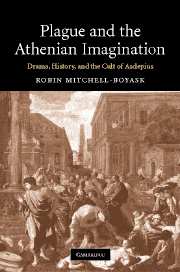Book contents
- Frontmatter
- Contents
- Preface
- Prologue
- Figure 1
- Chapter 1 Introduction
- Chapter 2 Death, myth and drama before the plague
- Chapter 3 Materials I: The language of disease in tragedy
- Chapter 4 Plague, cult and drama: Euripides' Hippolytus
- Chapter 5 Oedipus and the plague
- Chapter 6 The Trachiniae and the plague
- Chapter 7 Materials II: The cult of Asclepius and the Theater of Dionysus
- Chapter 8 Disease and stasis in Euripidean drama: Tragic pharmacology on the south slope of the Acropolis
- Chapter 9 The Athenian Asklepieion and the end of the Philoctetes
- Chapter 10 Conclusions and afterthoughts
- Works Cited
- Index
Chapter 3 - Materials I: The language of disease in tragedy
Published online by Cambridge University Press: 22 September 2009
- Frontmatter
- Contents
- Preface
- Prologue
- Figure 1
- Chapter 1 Introduction
- Chapter 2 Death, myth and drama before the plague
- Chapter 3 Materials I: The language of disease in tragedy
- Chapter 4 Plague, cult and drama: Euripides' Hippolytus
- Chapter 5 Oedipus and the plague
- Chapter 6 The Trachiniae and the plague
- Chapter 7 Materials II: The cult of Asclepius and the Theater of Dionysus
- Chapter 8 Disease and stasis in Euripidean drama: Tragic pharmacology on the south slope of the Acropolis
- Chapter 9 The Athenian Asklepieion and the end of the Philoctetes
- Chapter 10 Conclusions and afterthoughts
- Works Cited
- Index
Summary
A few decades ago, after philological examinations of very specific terms for types of bodily woes, scholars tended to dismiss the metaphorical aspects of disease in general out of hand, as “mere metaphor.” These scholars erred, I believe, in making sweeping assumptions about poetic language in its historical situation, in underestimating how rapid shifts in that situation could affect metaphoricity, and in not considering how their own historical conditions might have affected the way they read the Greek texts. Recently, G. E. R. Lloyd has more fundamentally cast doubt upon the traditional conception of metaphor as an analytical tool for Greek discourse, especially for studying the Greek terminology for disease (Lloyd 2003: 8–9):
It is unhelpful because it sets up a rigid dichotomy between a supposed primary, literal use and other deviant ones. Over and over again the key terms used in relation to health and disease pose severe problems for anyone who seeks an original “literal” sphere of application. I accordingly prefer to think of all the terms we shall be considering as possessing what I call “semantic stretch.” Indeed in my view all language exhibits greater or less semantic stretch.
In other words, can we really be so sure which use of nosos designates real illness and which is a trope? And could there not sometimes be slippages between the real and metaphorical applications of a word even inside the same text? Such slippages will quickly become apparent when I turn to examining specific dramas.
- Type
- Chapter
- Information
- Plague and the Athenian ImaginationDrama, History, and the Cult of Asclepius, pp. 18 - 44Publisher: Cambridge University PressPrint publication year: 2007

